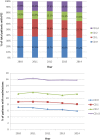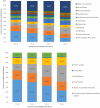Effect of Comorbidity On Unplanned Readmissions After Percutaneous Coronary Intervention (From The Nationwide Readmission Database)
- PMID: 30042466
- PMCID: PMC6057975
- DOI: 10.1038/s41598-018-29303-y
Effect of Comorbidity On Unplanned Readmissions After Percutaneous Coronary Intervention (From The Nationwide Readmission Database)
Abstract
It is unclear how comorbidity influences rates and causes of unplanned readmissions following percutaneous coronary intervention (PCI). We analyzed patients in the Nationwide Readmission Database who were admitted to hospital between 2010 and 2014. The comorbidity burden as defined by the Charlson Comorbidity Index (CCI). Primary outcomes were 30-day readmission rates and causes of readmission according to comorbidity burden. A total of 2,294,346 PCI procedures were included the analysis. The patients in CCI = 0, 1, 2 and ≥3 were 842,272(36.7%), 701,476(30.6%), 347,537(15.1%) and 403,061(17.6%), respectively. 219,227(9.6%) had an unplanned readmission within 30 days and rates by CCI group were 6.6%, 8.6%, 11.4% and 15.9% for CCI groups 0, 1, 2 and ≥3, respectively. The CCI score was also associated with greater cost (cost of index PCI for not readmitted vs readmitted was CCI = 0 $21,257 vs $19,764 and CCI ≥ 3 $26,736 vs $27,723). Compared to patients with CCI = 0, greater CCI score was associated with greater independent odds of readmission (CCI = 1 OR 1.25(1.22-1.28), p < 0.001, CCI ≥ 3 OR 2.08(2.03-2.14), p < 0.001). Rates of non-cardiac causes for readmissions increased with increasing CCI group from 49.4% in CCI = 0 to 57.1% in CCI ≥ 3. Rates of early unplanned readmission increase with greater comorbidity burden and non-cardiac readmissions are higher among more comorbid patients.
Conflict of interest statement
The authors declare no competing interests.
Figures





References
-
- Velders MA, et al. Prognosis of elderly patients with ST-elevation myocardial infarction treated with primary percutaneous coronary intervention in 2001 to 2011: a report from the Swedish Coronary Angiography and Angioplasty Registry (SCAAR) registry. Am Heart J. 2014;167:666e673. doi: 10.1016/j.ahj.2014.01.013. - DOI - PubMed
Publication types
MeSH terms
Grants and funding
LinkOut - more resources
Full Text Sources
Other Literature Sources
Medical
Miscellaneous

